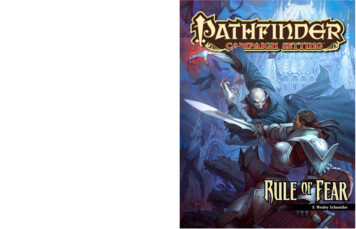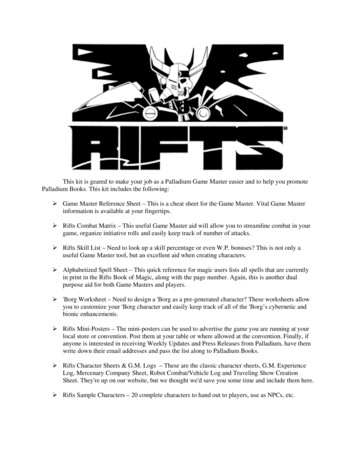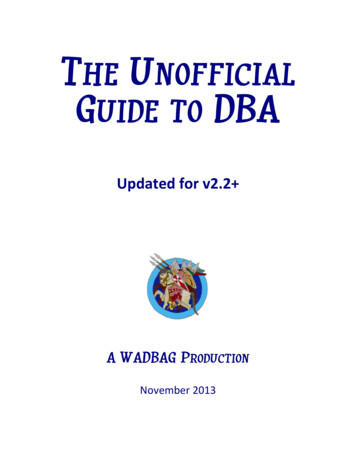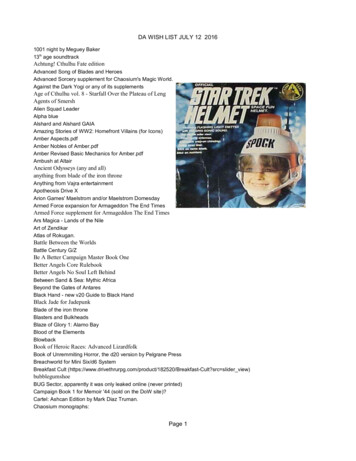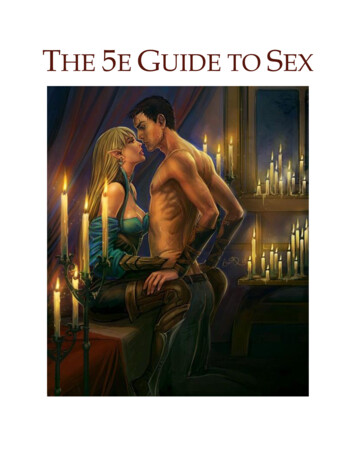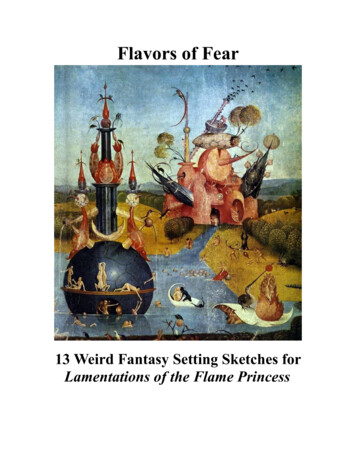
Transcription
Flavors of Fear13 Weird Fantasy Setting Sketches forLamentations of the Flame Princess
Flavors of Fear:13 Weird Fantasy Setting Sketches for Lamentations of the Flame PrincessAuthor's PrefaceThis project grew out of perusing the Suggested Reading section in the Grindhouse Edition of JamesRaggi's Lamentations of the Flame Princess. A reading list is nothing new when it comes to role-playinggames; after all, that grand grimoire known as the AD&D Dungeon Master's Guide contains the justlywell-loved Appendix N. That said, the Suggested Reading section found in Lamentations of the FlamePrincess is a bit different from what you may have come to expect: instead of just listing the authors andtitles of seminal works, Raggi and his fellow writers give an overview of both what you should be readingand why you should be reading it to inspire a properly Weird Fantasy atmosphere in your own gamesessions.The only problem was this: after reading it, I wanted more. You see, I've always been a fiend for Weirdstories. From a young age I was fascinated in equal measures by horror films, 1970s comics with titleslike The Witching Hour and The House of Mystery, ghost stories, and Gothic novels. I've been luckyenough to make studying Weird fiction my life's pursuit, so when I got to the end of the SuggestedReading section I lamented its brevity and mourned for all that was left out. Where was Arthur Machenand Ann Radcliffe? Hell, why restrict the pool of potential inspirations to just the written word? Wherewere the film suggestions, the gaming suggestions, and the bits of odd lore to be looked over and spuninto the stuff of Weird adventure?Consider this brief supplement my attempt to fill in that gap. As I pondered what had been left out of theGrindhouse Edition by necessity, I realized that the neglected titles and authors could be grouped togetherby the type of setting, thematic, and narrative conventions they employ. While it has the power tosurprise us, Weird Fantasy is nothing if not conventional. Inside this e-book you will find 13 “sketches”of variant campaign settings that you might use to evoke the classic conventions and eerie atmospheresfound in the Weird fiction of the past and present.Of course, the goal here isn't to bludgeon the players into conforming to a pre-determined fictionalschema; rather, my hope is that these sketches will give you a few basic tools and ideas so you can createa strange, uncanny setting of your own for your players to explore and react to in their own inimitableways.While this supplement was written with Lamentations of the Flame Princess in mind, there's nothingstopping you from exploring these setting sketches with your favorite fantasy RPG. Break outWarhammer Fantasy Role-Play, Call of Cthulhu, HarnMaster, etc. I've even given one of these settings atest drive with RISUS. Use what you like, just make it Weird.I would be remiss if I didn't acknowledge that I had some help along the way. I wish to thank thecommentators on my threads about this project on RPG.net and TheRPGSite for their valuablesuggestions and input. Also, I likely wouldn't have seen this project through to its conclusion withouttheir encouragement.Happy Gaming!Jack Shear
1. The Cold Northern Wind“In the foggy embraces of maternal woods, where wolves and red riding hoods are lost and found, wherestrange becomings take place, at night, you can here howls, growls, and grunts. Inarticulate wordscreate gothic soundscapes of abject horror and ritualistic transgression.”– Aspasia Stephanou, “Playing Wolves and Red Riding Hoods in Black Metal”George R.R. Martin's A Game of Thrones isn't a Weird tale, but the sections of the novel set at the Wall—an enormous barrier of ice that separates the Seven Kingdoms from the savage, unknown North—showall the signs of being rooted in the Weird tradition. The Wall is patrolled by the rangers of the Night'sWatch. Theirs is a grim duty: they withstand the howling, bitter winds of the icy North, struggle againstbarbarian raiders and wild beasts, and act as wardens against an evil race of mysterious beings knownonly as the Others. Life at the Wall is a mundane grind of military discipline and preparations for thecoming winter, but behind the banal trials and tribulations of the everyday lurks something ominous andsupernatural that threatens to break through. This particular constellation of conventions is a specific kindof Weird tale; it is a tale of bleakness, of the mad chaos of natural sublimity and natural savagery, ofroaring wind and deadly frost, and of bloody red against a field of snowy white. It is a tale of the ColdNorthern Wind.The Setting:An isolated northern outpost at the border between the civilized world and the unknowable wilderness.The outpost can be a garrison, a keep and its surrounding fiefdom, a trade town, or a rough, ramshacklerefuge for wanted criminals. The outpost is encircled by natural vistas that are both beautiful andthreatening: dense, primordial forests and rugged, towering mountain ranges. Every journey from theoutpost has the potential for danger; the wild beasts who live in the forests and mountains are ferociousand have a taste for human flesh. Beyond the outpost, the northlands become a blighted tundra that isboth unmapped and home to a grave, unknown menace.The Themes:The natural world is harsh and unforgiving—use the setting itself as an adversary against the characters.Emphasize the biting winds and the way the chilling frost can be felt in the characters' bones. Steal allwarmth and comfort from them.Civilization versus the Wild—make the outpost a place that the characters have a vested interest indefending. Make it clear that the outpost is civilization's first and best line of defense against somethingmonstrous that could spell doom for all humanity. Imperil their community; make them scramble toprotect the life they know.Grim fatalism—death is inevitable in the Weird north; it is something to faced with a stoic mien and ahardened heart. Put the characters in the position of making tough, if not impossible choices. Finalstands against the darkness are a must.
The Foes:The Frozen Dead—those who succumb to frostbite in the wilderness rise again as tireless enemies ofmankind. Their beards covered in hoar and the axes rimed with frost, they will ceaselessly pursue theliving through forest and mountain.Giants—not the dunderheaded giants usually found in fantasy, these are the vicious giants of northernlegend. They are more than mortal, they are the corrupted remnants of once-godlike nature spirits whowish to cleanse the land itself from the taint of man's civilizing influence.Wolves—in all their forms: dire wolves, werewolves, wolves who speak of blood in the voices of men,wolves who prowl the streets during the nightside eclipse. Never a single wolf; always an uncountablemultitude of wolves, a wolfing, an endless pack of tooth and claw.Wendigo—sometimes the howling of the winter wind is not just the howling of the winter wind,sometimes it is the ominous call of the wendigo. The wendigo has a voice like the bottomless depths, canlift a man from the earth with an unseen hand, burn him with cold, and drive him mad by showing himthings no mortal was meant to see.The Soundtrack:The Cold Northern Wind requires a soundtrack that is both pummeling and funereal.Xasthur, Portal of Sorrow—indulge in the melancholia of mystical, suicidal black metal.Blood of the Black Owl, A Feral Spirit—introspective doom metal; a ritual invocation of sublimewildness.Wolves in the Throne Room, Two Hunters—a black metal explication of man's alienation from the naturalworld.Neurosis, Enemy of the Sun—crushing, churning existential doom.Literary and Cinematic Inspirations:Antonia Bird's Ravenous, Algernon Blackwood's “The Wendigo,” John Carpenter's The Thing, AngelaCarter's “The Company of Wolves,” August Derleth's “Ithaqua,” Cristophe Gans's Brotherhood of theWolf, John Linqvist's Let the Right One In; Steve Niles, 30 Days of Night, Mary Shelley's Frankenstein(particularly the frame narrative), Snorri Sturlson's Prose Edda.Gaming Inspirations:Death Frost Doom and Weird New World (for Lamentations of the Flame Princess), Hellfrost (for SavageWorlds), Keep on the Borderlands (for D&D).Miscellaneous Inspirations:Alferd Packer and cannibalism, blood eagle, the Dyatlov Pass Incident, the Yeti.
2. Dark Medieval Times“Nay, said Balin, for this sword will I keep, but it be taken from me with force. Well, said the damosel, yeare not wise to keep the sword from me, for ye shall slay with the sword the best friend that ye have, andthe man that ye most love in the world, and the sword shall be your destruction. I shall take theadventure, said Balin, that God will ordain me, but the sword ye shall not have at this time, by the faith ofmy body.”– Thomas Mallory, Le Mort d'ArthurMany gamers associate D&D and the like with the Middle Ages, but they couldn't be further off the mark—historically speaking. The typical fantasy kingdom is place devoid of grit; there might be a classdivision between peasant and lord, but it doesn't tend to amount to much: peasant boys leave home andreturn as knights in service to their liege, the common people toil happily under the protection of kindlykings, and monsters are a known quantity instead of mysterious, folkloric beings who defy rationalunderstanding. All of that might be the stuff of typical fantasy, but it certainly isn't fit for a Weirdcampaign. In this case, the solution isn't to introduce more layers of the fantastic; rather, a fantasycampaign has much to gain in darkness, blood, and strangeness if it incorporates real (or even faux)medievalisms into the fabric of its setting.In the second introduction to his faux-medieval Gothic novel The Castle of Otranto, Horace Walpoleclaims that the purpose of his narrative was to explore how ordinary characters in a medieval settingwould react to the sudden introduction of the supernatural. That is the essence of Dark Medieval Times;crush the characters with the mundanity of their existence, then plunge them headlong into the Weird.The Setting:A petty fiefdom far from the centers of power. The fiefdom is regulated by a steward, sheriff, or minornobleman who has sworn fealty to the king. Most of the fiefdom is farmland tended by peasants who livehand-to-mouth; their lot in life is one of backbreaking labor, squalid conditions, and early death,punctuated only by the brief joys of festival days. The steward's lot is nothing to envy, but to the peasantsit seems luxurious; of course, the steward's household only mixes with the peasantry when customdemands it. There is a small church in town where a minor curate tends to the spiritual discipline of thecommunity. One end of the fief is bordered by a deep, nearly-impenetrable forest; some peasants, fed upwith their toil, have fled their farms to take up banditry in the woods. The other end of the fief isconnected to the trade road, but few come or go—the fiefdom exists in isolation.The Themes:Death is everywhere—life is brutal and short. Adjust in-game healing times and the availability ofhealing magic to make it explicitly apparent how dangerous the world is. Play up the high mortality rate;simple accidents will likely lead to fatal infections, the plague is feared by all, and combat results inmangled bodies and shattered skulls.Everyone is assigned a place by birth—emphasize the rigid social stratification of the setting. You'reborn a peasant and you die a peasant, no exceptions. Everyone in the setting knows their place and knowswho is their social better.The world beyond the fief is strange and mysterious—the vast majority of the fiefdom's residents willnever leave the place where they were born. Keep the action of your campaign isolated to the fief; eventhe characters should feel like they have no hope of ever seeing the greater world, even if they hear ofmarvelous things in lands they will never know.
The Foes:The Fair Folk—there are no silly sprites or cavorting leprechauns here. Instead, the Fair Folk areunknowable and alien; their motives are utterly unguessable. They have the power to beguile, ensnare,and lead astray. They have no souls and may be the remnants of the Old Gods. Some say they shoot mendown in the fields with unseen arrows just for sport.The Fell Pilgrims—wanderers and penitents who are not what they seem. They arrive hooded andcloaked, tolling bells, and chanting the psalms, but what are they really after? Do they bring disease orare they harbingers of the End Times?The Usurped Specter—the land on which the fief stands has known many masters. Perhaps the currentsteward gained the fief by wresting it from the rightful owner; the true lord of the land may have diedmad and imprisoned. His shade now walks the earth seeking vengeance for his betrayal.The Great Worm—a horrible beast allied with the Devil is said to sleep beneath the standing stones withinthe woods to the east of the fiefdom. All manner of malevolence is ascribed to the slumbering monster:when the crops fail, it is surely the work of the Worm; when a woman's child dies in infancy, it is surelythe work of the Worm; when a man is possessed by demons, it is surely the work of the Worm.The Soundtrack:Dark Medieval Times requires a soundtrack that is medieval-esque, without sounding like a Ren Faire.Dead Can Dance, Aion and Within the Realm of a Dying Sun—by turns mystical and haunting.The Soil Bleeds Black, Alchemie and The Knightly Years—neo-medieval compositions centered onoccultism and fatalistic valor.Arcana, The Dark Age of Reason—music from a Dark Age that never existed.Unto Ashes, Moon Oppose Moon and Saturn Return—witchy medievalism that is dark and otherworldly.Literary and Cinematic Inspirations:The anonymous Beowulf, the anonymous “Dream of the Rood,” the anonymous Gawain and the GreenKnight, Ingmar Bergman's The Seventh Seal, Richard Carpenter's Robin of Sherwood, Umberto Eco's TheNa
Death Frost Doom and Weird New World (for Lamentations of the Flame Princess), Hellfrost (for Savage Worlds), Keep on the Borderlands (for D&D). Miscellaneous Inspirations: Alferd Packer and cannibalism, blood eagle, the Dyatlov Pass Incident, the Yeti. 2. Dark Medieval Times “Nay, said Balin, for this sword will I keep, but it be taken from me with force. Well, said the damosel, ye are not .

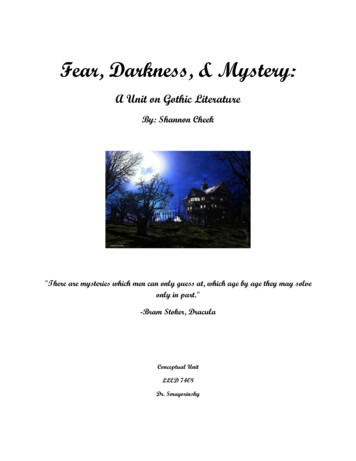
![Fear Nothing [039 5.0] By Dean R. Koontz](/img/5/fearnothing.jpg)
